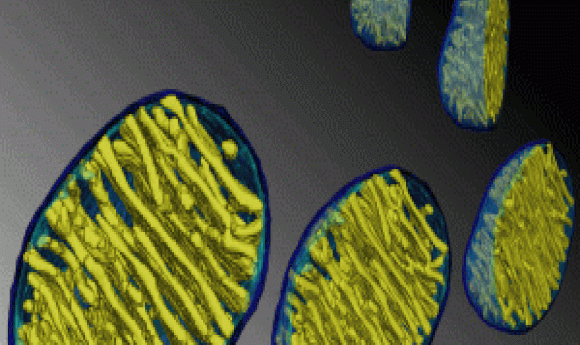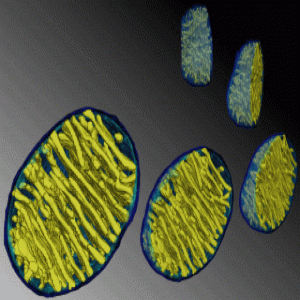Do mitochondria run at 122 degrees F?

Data from new fluorescent technology contradicts the basic assumption that mitochondria operate at body temperature. How hot do these subcellular structures actually get?

Mitochondrial membranes may act as radiators, heating the structure’s matrix.
Credit: Terrence G. Frey, San Diego State University
Since the human body temperature averages 98.6°F, many scientists assumed that physiological functions also happened at this temperature. Mitochondria generate the heat needed to maintain this temperature, but how much do we actually know about “the powerhouse of the cell”?
Now, a basic biological notion about mitochondria may have to change, according to researchers at the French National Institute of Health and Medical Research (INSERM), who were assisted by colleagues in Lebanon, Germany, Finland, and South Korea. Their new study suggested that our mitochondria actually function at nearly 122°F (50°C)—much higher than prior calculations.
“The high temperature we measured was initially surprising,” noted senior author Pierre Rustin. “Though, if you think about it, this temperature isn’t so amazing considering the high metabolic activity taking place in the mitochondria. But, honestly, it took more than two years of experimentation to convince ourselves.”
To maintain a constant body temperature, mitochondria act like thermostatic radiators in a leaky room, operating at a much higher temperature than their surroundings. Using a temperature-sensitive chemical probe where fluorescence decreases as temperature increases, the team inspected the centers of mitochondria in cultured, intact human embryonic kidney and skin fibroblasts (1). When these cells were placed in a culture medium maintained near body temperature, the molecular thermometer’s fluorescence dimmed, indicating that mitochondria were functioning at 50°F higher than their surroundings. Similar tests using inactivated mitochondria failed to demonstrate the same elevated temperature. The researchers also showed that multiple mitochondrial enzymes evolved to function optimally at a temperature of 122°F.
For Rustin, such a high temperature implies two major consequences for cell biology. First, “The reactions taking place in the mitochondria may be considerably more rapid—by 2 or 3 times—than previously thought,” he said. This should prompt reconsideration of properties of the mitochondrial membranes such as permeability, import/export rates, and structure. Second, “Reactions taking place outside of the mitochondria might be affected according to the proximity of warming mitochondria and to the changing structure of the mitochondrial network, as warming mitochondria can move and concentrate in a particular part of a cell (e.g. near the nucleus or at the extremity of a synapse),” he noted.
According to biochemist Nick Lane at University College London who didn’t participate in the INSERM study, “This finding challenges many of our cherished beliefs—whether it is right or wrong, or perhaps, more probably somewhere in between.” In his accompanying commentary, Lane termed the researchers’ conclusion “a radical claim” (2).
Acknowledging that the study controlled for issues such as pH and membrane potential, Lane suggested that other factors like tissue type could explain such high temperatures in mitochondria. “I doubt that the 10°C temperature difference should be taken literally,” he cautioned. “But, it should be taken seriously.”
Recognizing that their data pose questions about possible confounding factors and theoretical constraints, the INSERM team noted that only recently have tools emerged that allow temperature measurements at this scale.
If follow-up studies verify these findings, Rustin expects to see “a critical re-examination of the literature on mitochondria.”





